
Portrush is a small seaside resort town on the north coast of County Antrim, Northern Ireland. It neighbours the resort of Portstewart. The main part of the old town, including the railway station as well as most hotels, restaurants and bars, is built on a 1 mile (1.6 km)–long peninsula, Ramore Head. It had a population of 6,150 people at the 2021 Census.

Doagh is a village and townland in County Antrim, Northern Ireland. It is in the Six Mile Water Valley, about two miles south-west of Ballyclare, and had a population of 1,388 people in the 2011 census. It is known as Doach in Scots.

Sir Charles Lanyon DL, JP was an English architect of the 19th century. His work is most closely associated with Belfast, Northern Ireland.

William Henry Lynn (1829–1915) was an Irish-born architect with a practice in Belfast and the north of England. He is noted for his Ruskinian Venetian Gothic public buildings, which include Chester Town Hall and Barrow-in-Furness Town Hall.
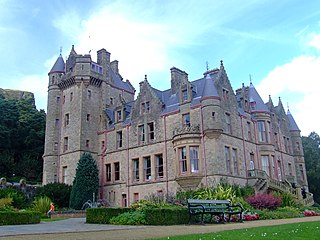
Lanyon, Lynn & Lanyon, Civil Engineers and Architects was a 19th-century firm working mainly in Dublin and Belfast, and the leading architectural firm in Belfast during the 1860s. Its partners were Charles Lanyon, William Henry Lynn, and Charles' son John Lanyon.

Causeway Coast and Glens is a local government district covering most of the northern part of Northern Ireland. It was created on 1 April 2015 by merging the Borough of Ballymoney, the Borough of Coleraine, the Borough of Limavady and the District of Moyle. The local authority is Causeway Coast and Glens Borough Council.
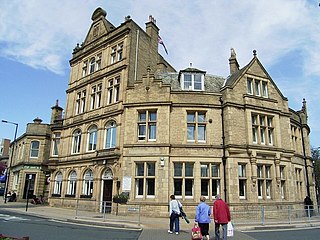
Keighley Town Hall is an early 20th century municipal building in Keighley, West Yorkshire, England. It is a Grade II listed building.
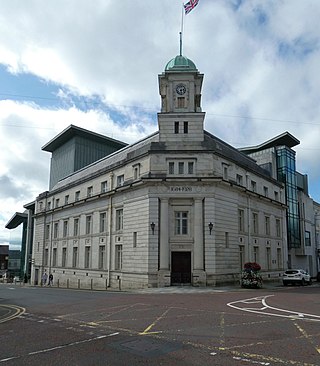
Ballymena Town Hall is a municipal structure in Bridge Street in Ballymena, County Antrim, Northern Ireland. The town hall, which is the headquarters of Mid and East Antrim Borough Council, is a Grade B1 listed building.

Carrickfergus Town Hall is a municipal structure in Joymount in Carrickfergus, County Antrim, Northern Ireland. The town hall, which was the headquarters of Carrickfergus Borough Council, is a Grade B+ listed building.
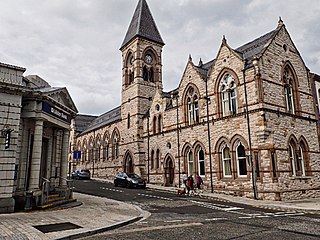
Larne Town Hall is a municipal structure in Upper Cross Street in Larne, County Antrim, Northern Ireland. The structure, which was the meeting place of Larne Borough Council, is a Grade B+ listed building.

The Roe Valley Arts & Cultural Centre, formerly the Alexander Memorial Hall and originally Limavady Town Hall, is a civic venue in Main Street in Limavady, County Londonderry, Northern Ireland. The structure, which incorporates the façade of the old town hall, was previously a Grade B1 listed building but was delisted in July 1998 to facilitate the demolition of the structure behind the façade and the subsequent erection of a new cultural centre.
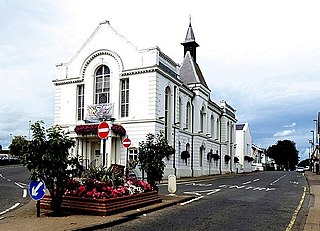
Ballymoney Town Hall is a municipal structure in the High Street, Ballymoney, County Antrim, Northern Ireland. The structure, which incorporates a local history museum, is a Grade B1 listed building.

Ballyclare Town Hall is a municipal structure in The Square, Ballyclare, County Antrim, Northern Ireland. The structure, which is primarily used as an events venue, is a Grade B2 listed building.

Llangollen Town Hall, is a municipal building in Castle Street, Llangollen, Denbighshire, Wales. The structure, which is the meeting place of Llangollen Town Council, is a Grade II listed building.

Talgarth Town Hall, is a municipal building on The Bank, Talgarth, Powys, Wales. The structure, which is the meeting place of Talgarth Town Council, is a Grade II listed building.

The Cheese Market in Hay-on-Wye, formerly Hay-on-Wye Town Hall,, is a municipal building in Market Street, Hay-on-Wye, Powys, Wales. The structure, which has been restored with support from the Heritage Lottery Fund so that the first floor can be let out for residential use, is a Grade II listed building.
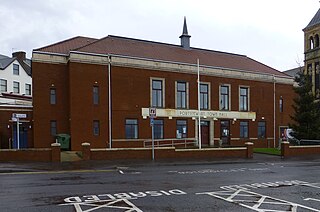
Portstewart Town Hall is a municipal structure in The Crescent, Portstewart, County Londonderry, Northern Ireland. The structure, which has been closed to the public since December 2019, is a Grade B2 listed building.

Dromore Town Hall is a municipal structure in the centre of Dromore, County Down. The structure, which is now used as a public library, is a Grade B1 listed building.

Ballynahinch Market House, formerly known as Ballynahinch Court House and as Ballynahinch Town Hall, is a municipal structure in the Market Square, Ballynahinch, County Down, Northern Ireland. The structure, which is used as a community events venue, is a Grade B1 listed building.
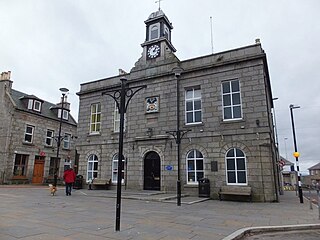
Oldmeldrum Town Hall is a municipal structure in the Market Square, Oldmeldrum, Aberdeenshire, Scotland. The structure, which is used as a community events venue, is a Category B listed building.






















